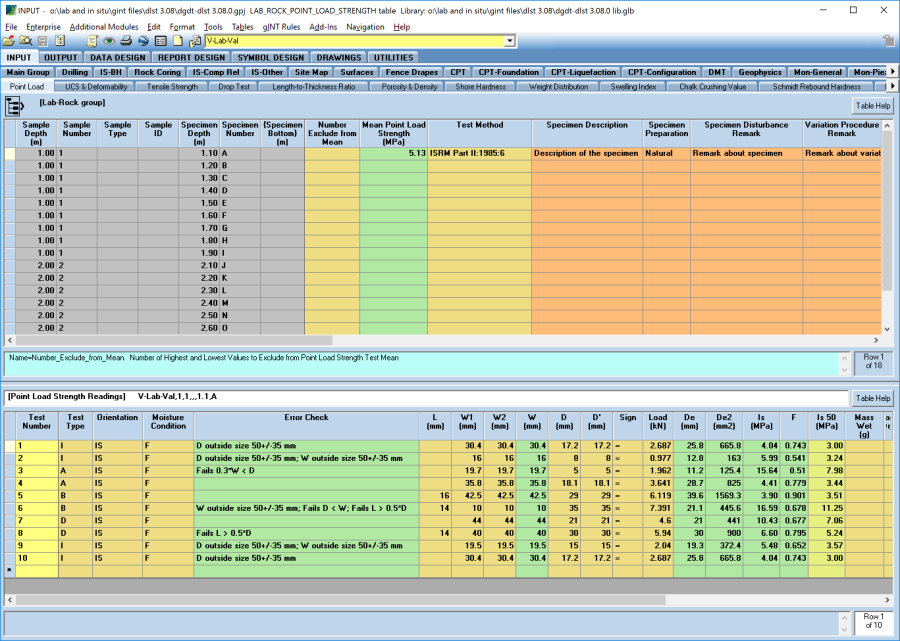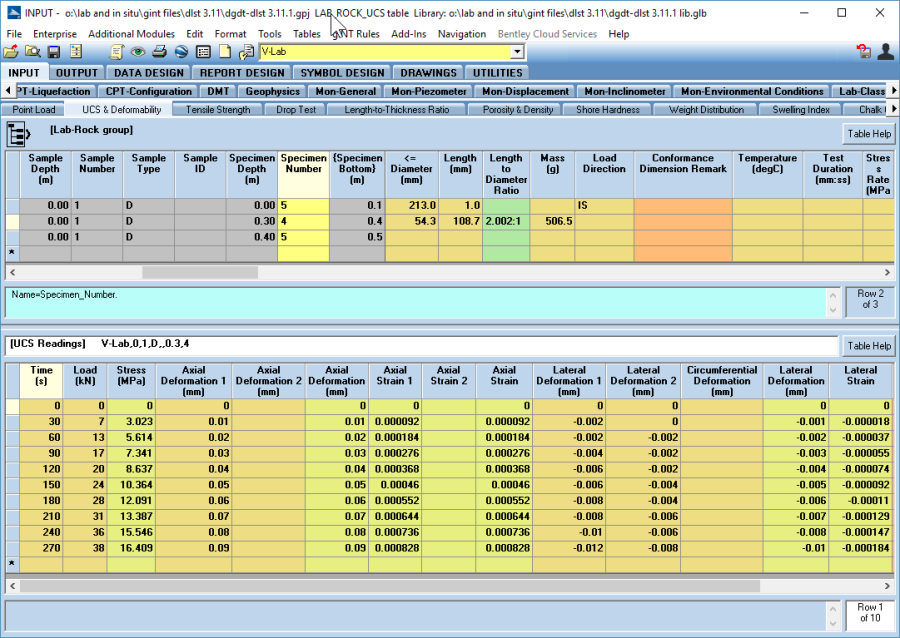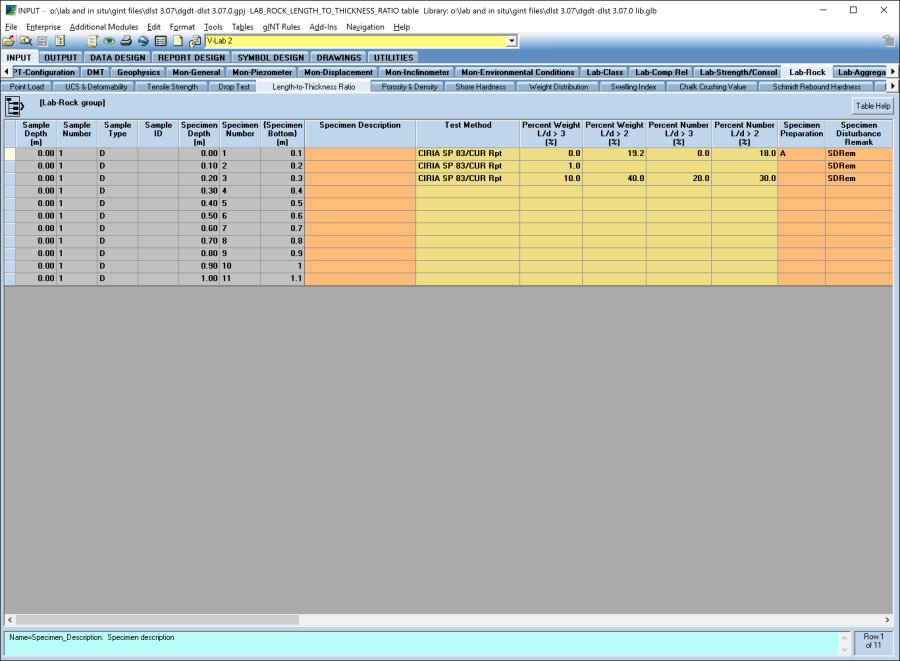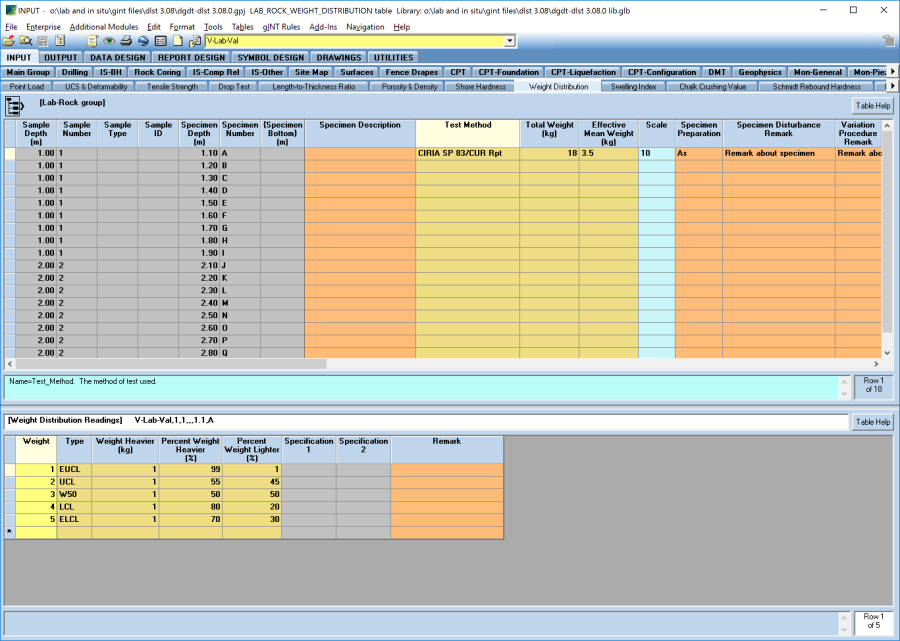Rock Lab Testing
Point Load Strength
Supported Test Methods
Standard | Description |
|---|---|
ISRM Part II:1985:6 | Suggested Method for Determining Point Load Strength |
Input
Lab-Rock | Point Load
To calculate the Is(50), you must first select the standard from the Test_Method field on the Point_Load table that the specimen is being tested against.
Enter the test data in the data entry fields in the lower table and clickSave, Ctrl+S or change table to initiate the calculation. The values will be calculated automatically and the result will be displayed in the calculated fields.
After a record is entered for the first time and saved, the first row will automatically copy down for fields where it might be useful.
The field Number_to_Exclude_from_Is50_Mean on Point_Load_Test (upper) table defines the number of highest and lowest values to exclude from point load strength test mean (eg. If Number_to_Exclude_from_Is50_Mean is 2, the two highest and the two lowest values will be excluded for the mean calculation). The excluded tests are shown in the Exclude_From_Mean check box.The net mean is written to the Point_Load_Test (upper) table.
Moisture contents for each specimen are recorded in the Moisture_Content table.
Output
- Graphic Text Report | L R POINT LOAD STRENGTH SAMP
- Histogram | A L R POINT LOAD INDEX
Uniaxial Compressive Strength and Young Modulus
Supported Test Methods
Standard | Description |
|---|---|
ISRM Part II:1978:10 | Suggested Method for Determining Point Load Strength |
BS EN 1926:2006 | Natural stone test methods. Determination of uniaxial compressive strength |
ASTM D7012-14:C&D | Compressive Strength and Elastic Moduli of Intact Rock Core Specimens under Varying States of Stress and Temperatures |
AS 4133.4.2-2013 | Determination of the uniaxial compressive strength |
Input
Lab-Rock | UCS & Deformability
To calculate the UCS and Young's Modulus values, you must first select the standard from the Test_Method field on the UCS_&_Deformability (upper) table that the specimen is being tested against. Then enter the necessary data in the data entry fields (Diameter, Length, Mass, Test_Duration, Stress_Rate, Strain_Rate, Youngs_Modulus_Determination and the Youngs_Modulus_Stress_Level).
Enter the test data in the data entry fields in the UCS_Readings (lower) table (Time, Load, Axial_Deformation_1, Axial_Deformation_2, Lateral_Deformation_1, Lateral_Deformation_2 or Circumferential_Deformation) and click Save, Ctrl+S or change row to initiate the calculation. The values will be calculated automatically and the result will be displayed in the calculated fields. The Lateral_Deformation will be calculated either using the values entered in the fields Lateral_Deformation_1 and Lateral_Deformation_2 or in the Circumferential_Deformation.
Output
- Graph | L R UCS
Drop Test
Input
Lab-Rock | Drop Test
Simply enter the values into the of Drop_Test_Breakage_Index, Median_Mass_Before_Test and Median_Mass_After_Test fields in the Drop_Test table. Data storage only, no calculations.
Output
- Graphic Text Report | L R DROP TEST
Length-to-Thickness Ratio
Input
Lab-Rock | Length-to-Thickness Ratio
Simply enter the values into the of Percent_Weight and Percent_Number fields in the Drop_Test table. Data storage only, no calculations.
Output
- Graphic Text Report | L R LENGTH-TO-THICKNESS RATIO
Weight Distribution
Input
Lab-Rock | Weight Distribution
Simply enter the values into the required fields in the Weight_Distribution (upper and Lower) tables. Data storage only, no calculations.
Output
- Graphic Report | L R WEIGHT DISTRIBUTION




